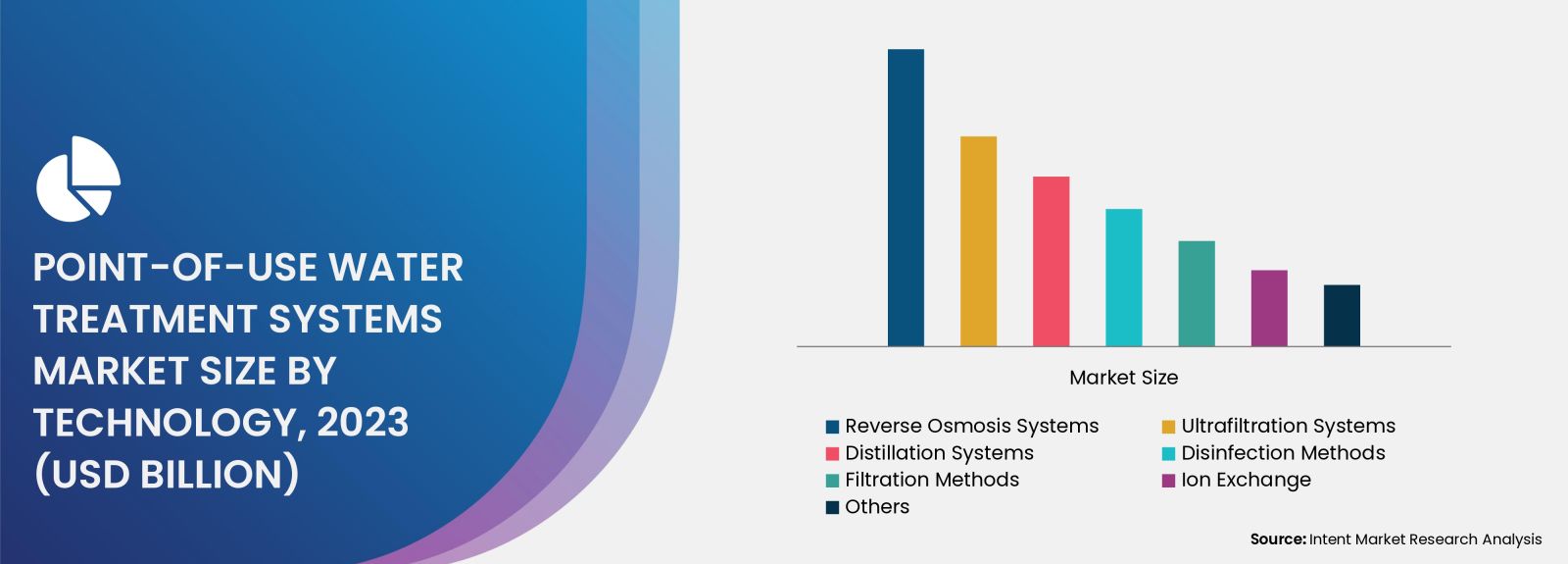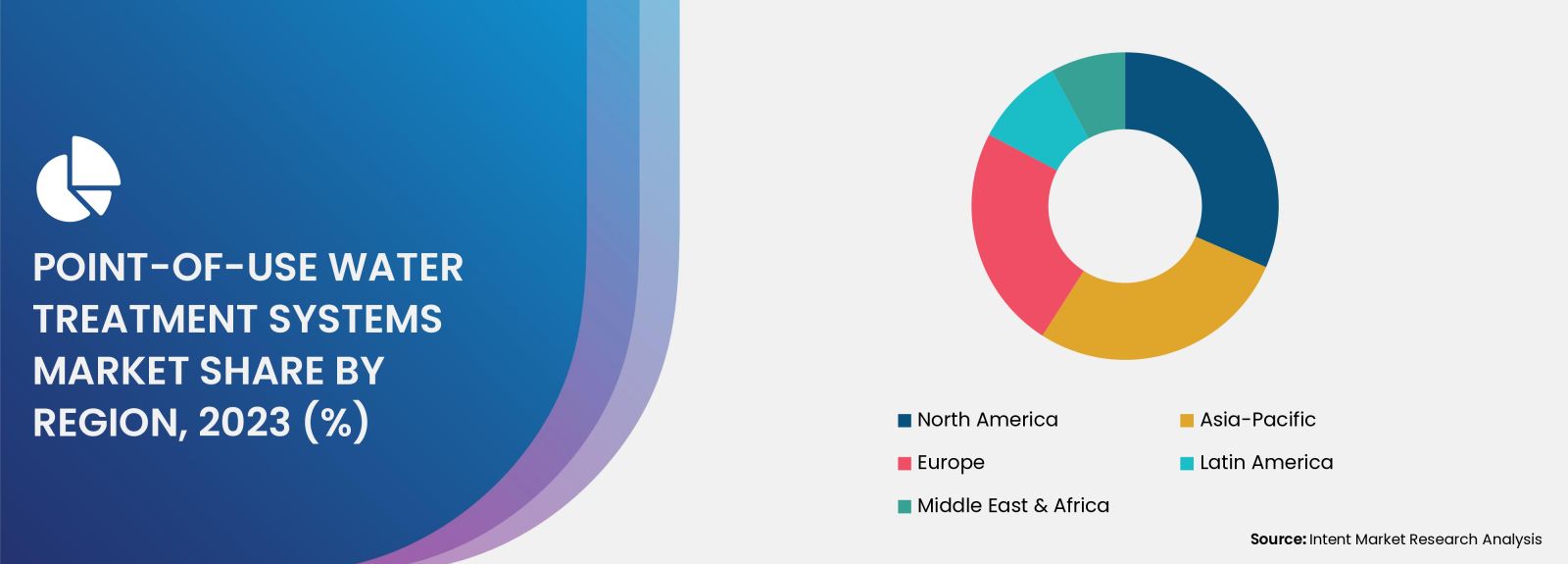As per Intent Market Research, the Point-of-Use Water Treatment Systems Market was valued at USD 21.3 billion in 2023 and will surpass USD 37.1 billion by 2030; growing at a CAGR of 8.2% during 2024 - 2030.

The RO Filters to Hold the Largest Market Share in the Point-of-Use Water Treatment Systems Market
The RO filters segment held the largest revenue share in the market. RO systems utilize advanced membrane filtration technology, effectively removing 99% of water contaminants and providing water quality comparable to bottled water. As a result, they are widely used for water purification and are regarded as the optimal solution for treating hard water. However, these systems can be costly, require more time for water treatment, and remove essential minerals like iron, magnesium, sodium, and calcium, which can affect the taste of the water.
 Asia Pacific to Hold the Largest Market Share and is Anticipated to be the Fastest-Growing Region
Asia Pacific to Hold the Largest Market Share and is Anticipated to be the Fastest-Growing Region
Rapid urbanization in the area presents significant growth opportunities for point-of-use water treatment systems. According to World Bank data, East Asia and the Pacific is the world's most rapidly urbanizing region, with an annual growth rate of 3%. One-third of the global urban population resides in this region. China is the leading consumer of water treatment systems, followed by Japan, driven by increasing awareness of the benefits of these systems. India is projected to experience the highest growth rate in the future. Japan, South Korea, and Australia exhibit the highest adoption rates of water treatment systems. As a result, Asia Pacific is expected to maintain its dominance in the market throughout the forecast period.

The report focuses on estimating the current market potential in terms of the total addressable market for all the segments, sub-segments, and regions. In the process, all the high-growth and upcoming technologies were identified and analyzed to measure their impact on the current and future market. The report also identifies the key stakeholders, their business gaps, and their purchasing behavior. This information is essential for developing effective marketing strategies and creating products or services that meet the needs of the target market. The report also covers a detailed analysis of the competitive landscape which includes major players, their recent developments, growth strategies, product benchmarking, and manufacturing operations among others. Also, brief insights on start-up ecosystem and emerging companies is also included as part of this report.
Report Objectives:
The report will help you answer some of the most critical questions in the Point-of-Use Water Treatment Systems Market. A few of them are as follows:
- What are the key drivers, restraints, opportunities, and challenges influencing the market growth?
- What are the prevailing technology trends in the Point-of-Use Water Treatment Systems Market?
- What is the size of the Point-of-Use Water Treatment Systems Market based on segments, sub-segments, and regions?
- What is the size of different market segments across key regions: North America, Europe, Asia-Pacific, Latin America, Middle East & Africa?
- What are the market opportunities for stakeholders after analyzing key market trends?
- Who are the leading market players and what are their market share and core competencies?
- What is the degree of competition in the market and what are the key growth strategies adopted by leading players?
- What is the competitive landscape of the market, including market share analysis, revenue analysis, and a ranking of key players?
Report Scope:
|
Report Features |
Description |
|
Market Size (2023) |
USD 21.3 billion |
|
Forecasted Value (2030) |
USD 37.1 billion |
|
CAGR (2024 – 2030) |
8.2% |
|
Base Year for Estimation |
2023 |
|
Historic Year |
2022 |
|
Forecast Period |
2024 – 2030 |
|
Report Coverage |
Market Forecast, Market Dynamics, Competitive Landscape, Recent Developments |
|
Segments Covered |
Point-of-Use Water Treatment Systems Market By Device Type (Tabletop Pitchers, Faucet-Mounted Filters, Counter-Top Units, Under-The-Sink Filters), By Technology (Reverse Osmosis Systems, Ultrafiltration Systems, Distillation Systems, Disinfection Methods, Filtration Methods, Ion Exchange), By Application (Residential, Non-Residential) |
|
Regional Analysis |
North America (US, Canada, Mexico), Europe (Germany, France, UK, Italy, Spain, and Rest of Europe), Asia-Pacific (China, Japan, South Korea, Australia, India, and Rest of Asia-Pacific), Latin America (Brazil, Argentina, and Rest of Latin America), Middle East & Africa (Saudi Arabia, UAE, Rest of Middle East & Africa) |
|
Customization Scope |
Customization for segments, region/country-level will be provided. Moreover, additional customization can be done based on the requirements |
|
1. Introduction |
|
1.1. Market Definition |
|
1.2. Scope of the Study |
|
1.3. Research Assumptions |
|
1.4. Study Limitations |
|
2. Research Methodology |
|
2.1. Research Approach |
|
2.1.1. Top-Down Method |
|
2.1.2. Bottom-Up Method |
|
2.1.3. Factor Impact Analysis |
|
2.2. Insights & Data Collection Process |
|
2.2.1. Secondary Research |
|
2.2.2. Primary Research |
|
2.3. Data Mining Process |
|
2.3.1. Data Analysis |
|
2.3.2. Data Validation and Revalidation |
|
2.3.3. Data Triangulation |
|
3.Executive Summary |
|
3.1. Major Markets & Segments |
|
3.2. Highest Growing Regions and Respective Countries |
|
3.3. Impact of Growth Drivers & Inhibitors |
|
3.4. Regulatory Overview by Country |
|
4. Point-of-Use Water Treatment Systems Market, by Device Type (Market Size & Forecast: USD Million, 2022 – 2030) |
|
4.1. Tabletop Pitchers |
|
4.2. Faucet-Mounted Filters |
|
4.3. Counter-Top Units |
|
4.4. Under-The-Sink Filters |
|
4.5. Others |
|
5. Point-of-Use Water Treatment Systems Market, by Technology (Market Size & Forecast: USD Million, 2022 – 2030) |
|
5.1. Reverse Osmosis Systems |
|
5.2. Ultrafiltration Systems |
|
5.3. Distillation Systems |
|
5.4. Disinfection Methods |
|
5.5. Filtration Methods |
|
5.6. Ion Exchange |
|
5.7. Others |
|
6. Point-of-Use Water Treatment Systems Market, by Application (Market Size & Forecast: USD Million, 2022 – 2030) |
|
6.1. Residential |
|
6.2. Non-Residential |
|
7. Regional Analysis (Market Size & Forecast: USD Million, 2022 – 2030) |
|
7.1. Regional Overview |
|
7.2. North America |
|
7.2.1. Regional Trends & Growth Drivers |
|
7.2.2. Barriers & Challenges |
|
7.2.3. Opportunities |
|
7.2.4. Factor Impact Analysis |
|
7.2.5. Technology Trends |
|
7.2.6. North America Point-of-Use Water Treatment Systems Market, by Device Type |
|
7.2.7. North America Point-of-Use Water Treatment Systems Market, by Technology |
|
7.2.8. North America Point-of-Use Water Treatment Systems Market, by Application |
|
7.2.9. By Country |
|
7.2.9.1. US |
|
7.2.9.1.1. US Point-of-Use Water Treatment Systems Market, by Device Type |
|
7.2.9.1.2. US Point-of-Use Water Treatment Systems Market, by Technology |
|
7.2.9.1.3. US Point-of-Use Water Treatment Systems Market, by Application |
|
7.2.9.2. Canada |
|
7.2.9.3. Mexico |
|
*Similar segmentation will be provided for each region and country |
|
7.3. Europe |
|
7.4. Asia-Pacific |
|
7.5. Latin America |
|
7.6. Middle East & Africa |
|
8. Competitive Landscape |
|
8.1. Overview of the Key Players |
|
8.2. Competitive Ecosystem |
|
8.2.1. Level of Fragmentation |
|
8.2.2. Market Consolidation |
|
8.2.3. Product Innovation |
|
8.3. Company Share Analysis |
|
8.4. Company Benchmarking Matrix |
|
8.4.1. Strategic Overview |
|
8.4.2. Product Innovations |
|
8.5. Start-up Ecosystem |
|
8.6. Strategic Competitive Insights/ Customer Imperatives |
|
8.7. ESG Matrix/ Sustainability Matrix |
|
8.8. Manufacturing Network |
|
8.8.1. Locations |
|
8.8.2. Supply Chain and Logistics |
|
8.8.3. Product Flexibility/Customization |
|
8.8.4. Digital Transformation and Connectivity |
|
8.8.5. Environmental and Regulatory Compliance |
|
8.9. Technology Readiness Level Matrix |
|
8.10. Technology Maturity Curve |
|
8.11. Buying Criteria |
|
9. Company Profiles |
|
9.1. Brita LP |
|
9.1.1. Company Overview |
|
9.1.2. Company Financials |
|
9.1.3. Product/Service Portfolio |
|
9.1.4. Recent Developments |
|
9.1.5. IMR Analysis |
|
*Similar information will be provided for other companies |
|
9.2. BWT Holding GmbH |
|
9.3. Coway USA, Inc. |
|
9.4. Honeywell International Inc. |
|
9.5. Katadyn Products Inc. |
|
9.6. LG Chem, Ltd. |
|
9.7. Panasonic Holdings Corporation |
|
9.8. Pentair |
|
9.9. TORAY INDUSTRIES, INC. |
|
9.10. Unilever PLC |
|
10. Appendix |
A comprehensive market research approach was employed to gather and analyze data on the Point-of-Use Water Treatment Systems Market. In the process, the analysis was also done to analyze the parent market and relevant adjacencies to measure the impact of them on the Point-of-Use Water Treatment Systems Market. The research methodology encompassed both secondary and primary research techniques, ensuring the accuracy and credibility of the findings.
.jpg)
Secondary Research
Secondary research involved a thorough review of pertinent industry reports, journals, articles, and publications. Additionally, annual reports, press releases, and investor presentations of industry players were scrutinized to gain insights into their market positioning and strategies.
Primary Research
Primary research involved conducting in-depth interviews with industry experts, stakeholders, and market participants across the Point-of-Use Water Treatment Systems ecosystem. The primary research objectives included:
- Validating findings and assumptions derived from secondary research
- Gathering qualitative and quantitative data on market trends, drivers, and challenges
- Understanding the demand-side dynamics, encompassing end-users, component manufacturers, facility providers, and service providers
- Assessing the supply-side landscape, including technological advancements and recent developments
Market Size Assessment
A combination of top-down and bottom-up approaches was utilized to analyze the overall size of the Point-of-Use Water Treatment Systems Market. These methods were also employed to assess the size of various subsegments within the market. The market size assessment methodology encompassed the following steps:
- Identification of key industry players and relevant revenues through extensive secondary research
- Determination of the industry's supply chain and market size, in terms of value, through primary and secondary research processes
- Calculation of percentage shares, splits, and breakdowns using secondary sources and verification through primary sources
.jpg)
Data Triangulation
To ensure the accuracy and reliability of the market size, data triangulation was implemented. This involved cross-referencing data from various sources, including demand and supply side factors, market trends, and expert opinions. Additionally, top-down and bottom-up approaches were employed to validate the market size assessment.
NA
